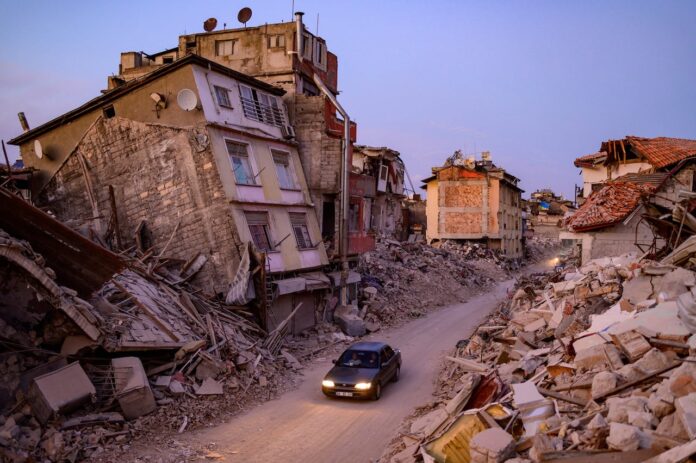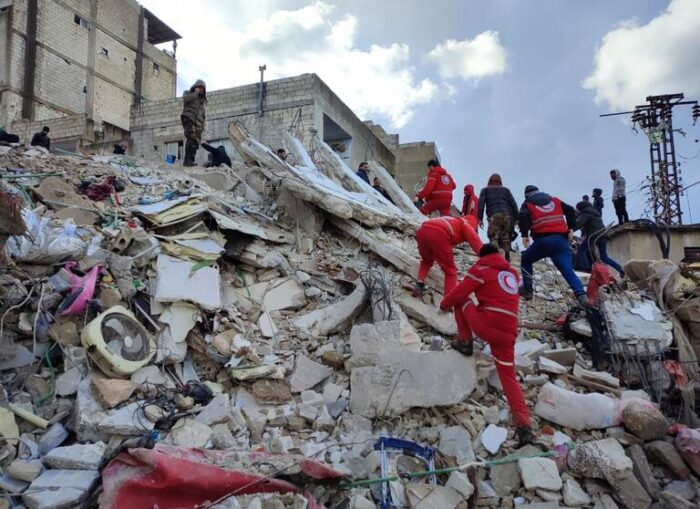
[ad_1]

Main earthquakes pose immense public well being threats each instantly after the shaking and within the extended restoration interval. Planning for post-earthquake challenges means public well being companies and their companions can swiftly present earthquake reduction when these devastating disasters strike.
Accidents and Trauma

The violent shaking of main quakes causes many crushing accidents and deaths from collapsing buildings and particles. Burns, lacerations, and bone fractures are additionally widespread. Trauma facilities can rapidly be overwhelmed with sufferers. Most of the injured could also be unable to succeed in medical care as a result of blocked roads, disabled automobiles, and poor communication.
Search and rescue efforts should prioritize entry for emergency automobiles into broken areas. Area hospitals could complement everlasting amenities after capability is exceeded. Stabilizing and treating accidents instantly minimizes everlasting disabilities. The individuals at Brother’s Brother Basis clarify that from collapsing infrastructure to environmental hazards, earthquakes create a fancy array of dangers that should be addressed to guard well being.
Illness Dangers
Unsanitary circumstances after earthquakes increase the dangers of communicable illness outbreaks. Compromised water infrastructure can improve waterborne diseases. Overcrowded shelters, lack of bogs, and restricted hygiene provides facilitate respiratory infections. Mosquitoes breeding in standing water could transmit vector-borne ailments. Routine vaccinations ought to proceed to guard towards preventable infections. Illness surveillance helps comprise potential outbreaks by early detection, testing and remedy. Defending water security and securing waste disposal are due to this fact priorities.
Psychological Well being Wants

Experiencing a traumatic earthquake can take a serious psychological toll that requires psychological well being help. Anxiousness, despair, and post-traumatic stress are widespread after disasters. Lack of family members and the stress of relocating and rebuilding can additional burden emotional wellbeing. Counseling providers, emergency hotlines, and community-based outreach can present psychosocial support to the displaced and weak. Screening youngsters for trauma helps direct school-based providers. We should sustainably help coping assets by an extended restoration.
Environmental Hazards
Earthquake environmental impacts generate well being dangers. Poisonous chemical leaks from broken factories or storage websites contaminate water and soil. Ruptured gasoline traces, oil tanks, and sewers could pollute neighborhoods. Detailed environmental assessments establish hazards for containment. Air high quality monitoring ensures heavy mud and particles just isn’t inhaled. When water infrastructure is severely compromised, supplying clear bottled water prevents waterborne sickness. Cleanup efforts should correctly remediate poisonous threats.
Energy and Healthcare Disruptions
Widespread energy outages can disrupt lifesaving remedies and emergency care. Hospitals with backup mills preserve important capabilities, however smaller clinics could lack energy. Oxygen provides for respiratory sufferers could also be restricted. Refrigeration for medicines and vaccines may fail. Transferring sufferers to operable amenities ensures continuity of care. Moreover, broken roads isolate many earthquake survivors from healthcare till transport is restored. Air ambulances and emergency lanes allow entry to help.
Meals and Housing Insecurity

Disrupted provide chains threaten meals safety after earthquakes. Injury to farms, processing crops, warehouses, and shops limits availability. Transportation blockages stop distribution. Flooding from burst water pipes ruins saved meals. Rationing, meals banks, and cell vitamin providers present sustenance. Habitat loss additionally creates housing shortages, with displacement strains compounded by broken homeless shelters. Repairing or changing protected properties is crucial to help public well being throughout extended restoration and rebuilding.
Ongoing Resilience Planning
Past the rapid earthquake response, public well being companies play an important function in long-term resilience planning to mitigate future earthquake impacts. Analyzing catastrophe responses and incorporating classes realized strengthens readiness. Robust public well being partnerships throughout authorities, healthcare networks and neighborhood organizations increase capability to quickly deal with earthquake challenges.
Enhanced Emergency Communication Methods
One important space of enchancment in managing earthquake disasters is enhancing emergency communication techniques. Environment friendly communication channels are very important for coordinating rescue operations, disseminating public well being info, and organizing reduction efforts. Upgrading expertise to make sure sturdy communication even when conventional techniques fail is essential. Satellite tv for pc telephones, emergency broadcast techniques, and cell apps can present real-time updates and join remoted people with emergency providers. Coaching neighborhood members in utilizing these applied sciences ensures a simpler response throughout a disaster.
Neighborhood-Based mostly Catastrophe Preparedness

Partaking communities in catastrophe preparedness considerably strengthens the general response to earthquakes. Neighborhood-based coaching applications in first support, emergency response, and primary healthcare can empower residents to be the primary line of response when skilled assistance is delayed. Establishing native volunteer teams and catastrophe committees enhances neighborhood resilience. These teams may play a key function in disseminating details about earthquake preparedness and security measures, making certain that communities are higher geared up to deal with the aftermath of a catastrophe.
Lengthy-Time period Psychological Help Providers
Whereas rapid psychological well being help is essential, the long-term psychological impacts of earthquakes additionally demand consideration. Creating sustainable psychological well being providers, together with ongoing counseling and help teams, is crucial for the long-term restoration of affected people. Faculty-based applications to help youngsters, in addition to neighborhood workshops specializing in coping methods and resilience-building, can mitigate long-term psychological impacts. Moreover, coaching neighborhood leaders and academics in primary psychological well being help can prolong the attain of those providers.
Infrastructure Resilience and Retrofitting
Enhancing the resilience of infrastructure to face up to earthquakes can considerably scale back the general public well being influence of such disasters. Strengthening buildings, bridges, and different important infrastructure by retrofitting and adherence to stringent constructing codes can stop widespread destruction. City planning that considers seismic dangers and the incorporation of earthquake-resistant supplies in building initiatives are important measures. This method not solely minimizes the rapid influence of earthquakes but in addition ensures faster restoration by decreasing the extent of harm.
Public Well being Training and Consciousness
Educating the general public about earthquake dangers and preparedness is one other important facet of managing public well being challenges. Common public consciousness campaigns, faculty applications, and neighborhood workshops ought to concentrate on instructing people the best way to reply throughout and after an earthquake. Data on constructing a primary emergency equipment, understanding the indicators of trauma, and accessing emergency providers can considerably enhance particular person and neighborhood resilience. Leveraging social media and different digital platforms can improve the attain of those academic efforts.
Strengthening Emergency Medical Providers

Enhancing emergency medical providers (EMS) capabilities is significant for addressing the surge in medical wants following an earthquake. Investing in cell medical models, telemedicine providers, and coaching extra emergency medical personnel can enhance the response capability. Guaranteeing that EMS groups have entry to mandatory medical provides, together with emergency medicines, trauma care gear, and cell surgical models, is crucial. Common drills and simulations may help in sustaining a state of readiness amongst these groups.
Conclusion
Successfully managing the general public well being challenges posed by main earthquakes requires a multifaceted method. By specializing in areas resembling communication, neighborhood preparedness, long-term psychological well being help, infrastructure resilience, public schooling, and strengthening EMS, public well being companies and their companions can considerably enhance their response to those devastating occasions. This complete method not solely saves lives within the rapid aftermath but in addition helps the long-term restoration and resilience of affected communities.
[ad_2]